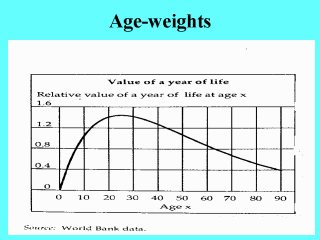 |
Age weighting
means that life years in young and old age are counted less. This figure shows the
relative value assigned to each year of life in the calculation of disease burden.
Source:World Bank, 1993 . The relative value of a life year is below one for children
under 10, and for persons more than about 55 years of age. This implies that in the
calculations, a life year lost for children is given less weight than a life year lost for
adults below 55. The adjustments made, introduces (explicitly), a bias both against
children and the elderly. In a defence of age-weights, Christopher Murray argues that
there is a widespread preference for age weighting in most cultures (Murray, 1996), and,
that on average, these preferences can be expressed as in the function given. |
